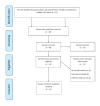Use of Social Robots in Mental Health and Well-Being Research: Systematic Review
- PMID: 31342908
- PMCID: PMC6685125
- DOI: 10.2196/13322
Use of Social Robots in Mental Health and Well-Being Research: Systematic Review
Abstract
Background: Technology-assisted clinical interventions are increasingly common in the health care field, often with the proposed aim to improve access to and cost-effectiveness of care. Current technology platforms delivering interventions are largely mobile apps and online websites, although efforts have been made to create more personalized and embodied technology experiences. To extend and improve on these platforms, the field of robotics has been increasingly included in conversations of how to deliver technology-assisted, interactive, and responsive mental health and psychological well-being interventions. Socially assistive robots (SARs) are robotic technology platforms with audio, visual, and movement capabilities that are being developed to interact with individuals socially while also assisting them with management of their physical and psychological well-being. However, little is known about the empirical evidence or utility of using SARs in mental health interventions.
Objective: The review synthesizes and describes the nascent empirical literature of SARs in mental health research and identifies strengths, weaknesses, and opportunities for improvement in future research and practice.
Methods: Searches in Medline, PsycINFO, PsycARTICLES, PubMed, and IEEE Xplore yielded 12 studies included in the final review after applying inclusion and exclusion criteria. Abstract and full-text reviews were conducted by two authors independently.
Results: This systematic review of the literature found 5 distinct SARs used in research to investigate the potential for this technology to address mental health and psychological well-being outcomes. Research on mental health applications of SARs focuses largely on elderly dementia patients and relies on usability pilot data with methodological limitations.
Conclusions: The current SARs research in mental health use is limited in generalizability, scope, and measurement of psychological outcomes. Opportunities for expansion of research in this area include diversifying populations studied, SARs used, clinical applications, measures used, and settings for those applications.
Keywords: interventions; mental health; social robotics; socially assistive robots.
©Arielle AJ Scoglio, Erin D Reilly, Jay A Gorman, Charles E Drebing. Originally published in the Journal of Medical Internet Research (http://www.jmir.org), 24.07.2019.
Conflict of interest statement
Conflicts of Interest: None declared.
Figures
References
-
- Lawrence D, Kisely S. Inequalities in healthcare provision for people with severe mental illness. J Psychopharmacol. 2010 Nov;24(4 Suppl):61–68. doi: 10.1177/1359786810382058. http://europepmc.org/abstract/MED/20923921 - DOI - PMC - PubMed
-
- Dahl T, Boulos M. Robots in health and social care: a complementary technology to home care and telehealthcare? Robotics. 2013 Dec 30;3(1):1–21. doi: 10.3390/robotics3010001. - DOI
Publication types
MeSH terms
LinkOut - more resources
Full Text Sources
Other Literature Sources
Medical
Miscellaneous



